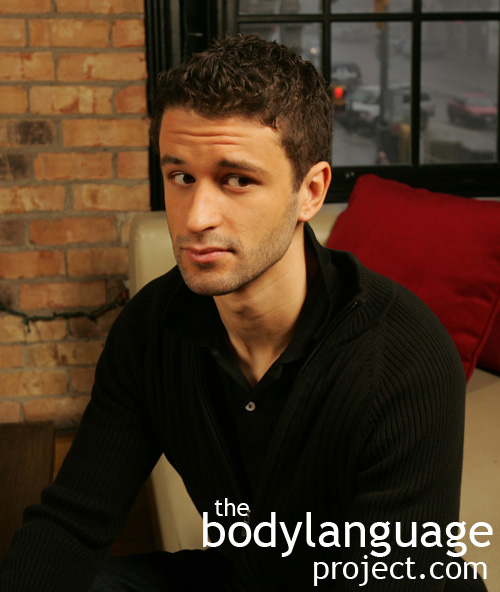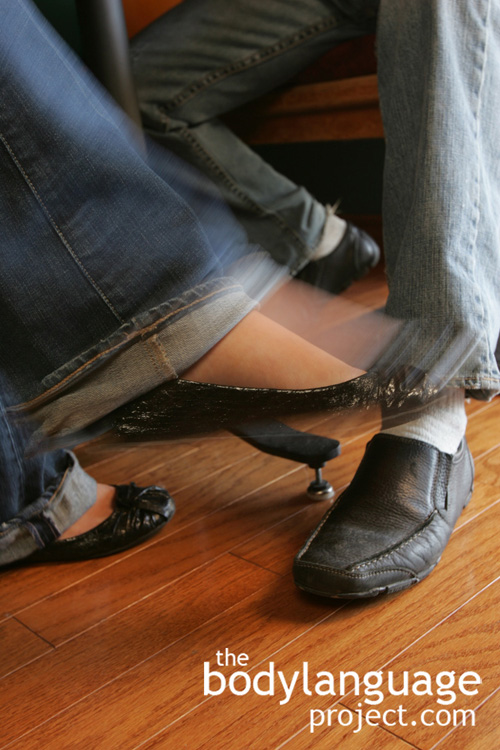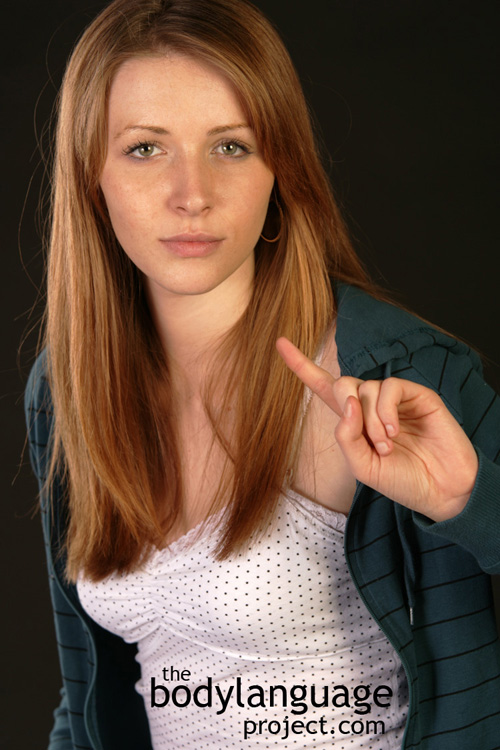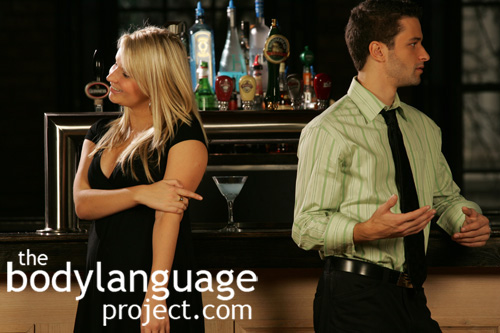Body Language of Furrowed Forehead
Synonym(s): Forehead Creasing, Wrinkled Forehead, Forehead Furrow.
Description: Frowning done by creasing the forehead and brow.
In One Sentence: A furrowed forehead is a sign of negative thoughts.
How To Use it: Furrow the forehead when you want others to visually see that you are not in a positive mood. This can be effective in showing your disapproval of others which may cause them to change their behaviour in order to better please you. Furrowing the forehead works well on children as it does with any submissive audience. The honest portrayal of disapproval through furrowed forehead works to influence others as people are strongly social and do not cope well with the anger of others. Showing disapproval nonverbally avoids a deeper potentially aggressive verbal confrontation, but at the same time, is obvious to onlookers.
Context: General.
Verbal Translation: “Muscles in my forehead are scrunching up to show how badly I feel on the inside.”
Variant: Various other forms of contraction can occur in the face such as the lips, nose and eyes to show negative thoughts. See Compressed Lips, Nose Crinkle, Sneering, Eye Squinting or Narrowing Eyes.
Cue In Action: She was worried that he was going to be upset for being so late for their date that her forehead began to wrinkle and her skin flushed red. She was harried and quickly left her house in a panic.
Meaning and/or Motivation: Wrinkled forehead is one of the quickest ways to detect when a person carries negative thoughts. It can signify anything from anxiousness, sadness, concentration, concern, worry, bewilderment or anger. The cluster of cues which accompany the forehead furrow will give clues to its underlying meaning.
Anger is shown through furrowed forehead coupled with finger pointing, overall tensing of the body or tightening of the jaw and lips (called “lip occlusion”), quivering in the lips, frowning, dilated pupils, squinting of the eyes, crotch displays such as legs open, sneering or flared nostrils, or extreme body loosening to ready for fighting.
Surprise is coupled with a straight upward lift of the forehead whereas fear engages the muscles between the brows folding them. Fear is sometimes confused with surprise as in much of the world only subtle differences exist.
During fear, eyebrows rise and are pulled together, and curve although less than in surprise. Wrinkles appear in the forehead, but do not cross the entire forehead like in the surprised expression. The upper eyelids rise, as in the surprise expression, to expose the white of the eyes and the lower eyelids also rise. The lips may be stretched back and the mouth opened.
Sadness is controlled mainly by the mouth where it drops at the corners. The inner eyebrows rise producing a triangular shape between the root of the nose and the eyes. The forehead might show wrinkles and the eyes may appear moist with tears.
Cue Cluster: See Meaning and/or Motivation.
Body Language Category: Amplifier, Aggressive body language, Anger, Confused body language, Closed facial gestures, Emotional body language, Fearful body language, Hostile body language, Microexpression, Stressful body language, Universal gestures, Universal facial expressions, Worry body language.
Resources:
Bard, K. A. (2003). Development of emotional expressions in chimpanzees (Pan troglodytes). In P. Ekman, J. Campos, R. J. Davidson & F. B. M. De Waal (Eds.), Emotions inside out: 130 years after Darwin’s The Expression of the Emotions in Man and Animals (Vol. 1000, pp. 88-90). New York: Annals of the New York Academy of Sciences.
Baron, R. M., & Kenny, D. A. (1986). The moderator-mediator variable distinction in social psychological research: Conceptual, strategic, and statistical considerations. Journal of Personality and Social Psychology, 51(6), 1173-1882.
Biehl, M., Matsumoto, D., Ekman, P., Hearn, V., Heider, K., Kudoh, T., et al. (1997). Matsumoto and Ekman’s Japanese and Caucasian Facial Expressions of Emotion (JACFEE): Reliability Data and Cross-National Differences. Journal of Nonverbal Behavior, 21, 3-21.
Carroll E. 1994. Innate and universal facial expressions: Evidence from developmental and cross-cultural research Izard, Psychological Bulletin. 115(2): 288-299.
Daniel H. Lee, Reza Mirza, John G. Flanagan and Adam K. Anderson. Optical Origins of Opposing Facial Expression Actions. Psychological Science published online 24 January 2014 DOI: 10.1177/0956797613514451
http://bodylanguageproject.com/articles/eyes-and-facial-expressions-may-be-biologically-controlled-serve-a-real-non-emotional-purpose-says-research/
de Waal, F. B. M. (2003). Darwin’s legacy and the study of primate visual communication. In P. Ekman, J. Campos, R. J. Davidson & F. B. M. De Waal (Eds.), Emotions inside out: 130 years after Darwin’s The Expression of Emotion in Man and Animals (pp. 7-31). New York: New York Academy of Sciences.
Duan, Xujun ; Dai, Qian ; Gong, Qiyong ; Chen, Huafu. Neural mechanism of unconscious perception of surprised facial expression. NeuroImage. 2010. 52(1): 401-407.
e Charlesworth, W. R. (1964). Instigation and maintenance of curiosity behavior as a function of surprise versus novel and familiar stimuli. Child Development, 35, 1169–1186.
Ekman, P. & O’Sullivan, M. (1991). Who can catch a liar? American Psychologist. 46, 913-920.
Ekman, Paul. 1994. Strong evidence for universals in facial expressions: A reply to Russell’s mistaken critique Psychological Bulletin. 115(2): 268-287.
Ekman, Paul. 1986. A new pan-cultural facial expression of emotion. Source: Motivation and Emotion Ekman. 10(2): 159-168.
Ekman, Paul and Friesen, W. V. 1987. Universals and cultural differences in the judgments of facial expressions of emotion. Journal of Personality and Social Psychology. 53(4): 712-717.
Ekman, Paul; Friesen, Wallace V. 1971. Constants across cultures in the face and emotion. Journal of Personality and Social Psychology. 17(2): 124-129.
Ekman, Paul. 1972. Universals and cultural differences in facial expressions of emotion. In J. Cole (Ed.), Nebraska Symposium on Motivation, 1971. 19: 207-282. Lincoln: University of Nebraska Press.
Ekman, P., Levenson, R. W., & Friesen, W. V. (1983). Autonomic nervous system activity distinguishes among emotions. Science, 221(4616), 1208-1210.
Ekman, P., O’Sullivan, M., & Matsumoto, D. (1991a). Confusions about context in the judgment of facial expression: A reply to “The contempt expression and the relativity thesis.”. Motivation & Emotion, 15(2), 169-176.
Ekman, P., O’Sullivan, M., & Matsumoto, D. (1991b). Contradictions in the study of contempt: What’s it all about? Reply to Russell. Motivation & Emotion, 15(4), 293-296.
Elfenbein, H. A., & Ambady, N. (2002). On the universality and cultural specificity of emotion recognition: A meta-analysis. Psychological Bulletin, 128(2), 205-235.
Fulcher, J. S. “Voluntary” facial expression in blind and seeing children. Archives of Psychology, 1942. 38: 272.
Friesen, W. V. 1972. Cultural differences in facial expressions in a social situation: An experimental test of the concept of display rules. Unpublished doctoral dissertation, University of California, San Francisco.
James A. Russell, Naoto Suzuki and Noriko Ishida. 1993. Canadian, Greek, and Japanese freely produced emotion labels for facial expressions. Motivation and Emotion. 17(4): 337 -351
Russell, James A. 1995. Facial Expressions of Emotion: What Lies Beyond Minimal Universality? Psychological bulletin. 118(3): 379-391.
Russell, James A. 1994. Is There Universal Recognition of Emotion From Facial Expression? A Review of the Cross-Cultural Studies. Psychological Bulletin. 115(1): 102-141.
Susskind, Joshua M and Adam K Anderson. Facial Expression Form and Function. Communicative Integrative Biology. 2008. 1(2): 148–149. PMCID: PMC2686004
http://bodylanguageproject.com/articles/emotional-facial-expressions-evolve/
Levenson, R. W., Ekman, P., & Friesen, W. V. (1990). Voluntary facial action generates emotion-specific autonomic nervous system activity. Psychophysiology, 27(4), 363-384.
Levenson, R. W., Ekman, P., Heider, K., & Friesen, W. V. (1992). Emotion and autonomic nervous system activity in the Minangkabau of West Sumatra. Journal of Personality & Social Psychology, 62(6), 972-988.
Ludden, G. D. S., Schifferstein, H. N. J., & Hekkert, P. (2009). Visual–tactual incongruities in products as sources of surprise. Empirical Studies of the Arts, 27, 63–89.
Mori, K., & Mori, H. (2010) Examination of the passive facial feedback hypothesis using an implicit measure: with a furrowed brow, neutral objects with pleasant primes look less appealing. Perceptual and Motor Skills, 111, 785-789.
Matsumoto, D. (1989). Cultural influences on the perception of emotion. Journal of Cross-Cultural Psychology, 20(1), 92-105.
Matsumoto, D. (1992). American-Japanese cultural differences in the recognition of universal facial expressions. Journal of Cross-Cultural Psychology, 23(1), 72-84.
Matsumoto, D. (2001). Culture and Emotion. In D. Matsumoto (Ed.), The Handbook of Culture and Psychology (pp. 171-194). New York: Oxford University Press.
Matsumoto, D., & Ekman, P. (1989). American-Japanese cultural differences in intensity ratings of facial expressions of emotion. Motivation & Emotion, 13(2), 143-157.
Matsumoto, D., Keltner, D., Shiota, M. N., Frank, M. G., & O’Sullivan, M. (2008). What’s in a face? Facial expressions as signals of discrete emotions. In M. Lewis, J. M. Haviland & L. Feldman Barrett (Eds.), Handbook of emotions (pp. 211-234). New York: Guilford Press.
Matsumoto, D., & Willingham, B. (2009). Spontaneous Facial Expressions of Emotion of Congenitally and Non-Congenitally Blind Individuals. Journal of Personality and Social Psychology, 96(1), 1-10.
Mesquita, B., & Frijda, N. H. (1992). Cultural variations in emotions: A review. Psychological Bulletin, 112, 197-204.
McClure, Erin B 2000. A meta-analytic review of sex differences in facial expression processing and their development in infants, children, and adolescents
Psychological Bulletin. 126(3): 424-453.
Mead, M. 1975. Review of “Darwin and facial expression.” Journal of Communication, 25: 209-213.
Peleg, G., Katzir, G., Peleg, O., Kamara, M., Brodsky, L., Hel-Or, H., et al. (2006). Heriditary family signature of facial expression. Proceedings from the National Academy of Sciences, 103(43), 15921-15926.
Parzuchowski, Michal ; Szymkow-Sudziarska, Aleksandra. Well, slap my thigh: expression of surprise facilitates memory of surprising material. Emotion. 2008. 8(3): 430-4.
Reisenzein, R. (2000). Exploring the strength of association between the components of emotion syndromes: the case of surprise. Cognition and Emotion, 14, 1–38.
Reisenzein, R., Bördgen, S., Holtbernd, T., & Matz, D. (2006). Evidence for strong dissociation between emotion and facial displays: the case of surprise. Journal of Personality and Social Psychology, 91, 295–315.
Reisenzein, R., & Studtmann, M. (2007). On the expression and experience of surprise: no evidence for facial feedback, but evidence for a reverse self-inference effect. Emotion, 7, 612–627.
Scherer, K. R., Zentner, M. R., & Stern, D. (2004). Beyond surprise: the puzzle of infants’ expressive reactions to expectancy violation. Emotion, 4, 389–402.
Schützwohl, Achim ; Reisenzein, Rainer. Facial expressions in response to a highly surprising event exceeding the field of vision: a test of Darwin’s theory of surprise. Evolution and Human Behavior. 2012. 33(6): 657-664.
Vrticka, Pascal ; Lordier, Lara ; Bediou, Benoît ; Sander, David Desteno, David (editor). Human Amygdala Response to Dynamic Facial Expressions of Positive and Negative Surprise. Emotion. 2014. 14(1): 161-169.
Vanhamme, J. (2000). The link between surprise and satisfaction: an exploratory research on how to best measure surprise. Journal of Marketing Management, 16, 565–582.








